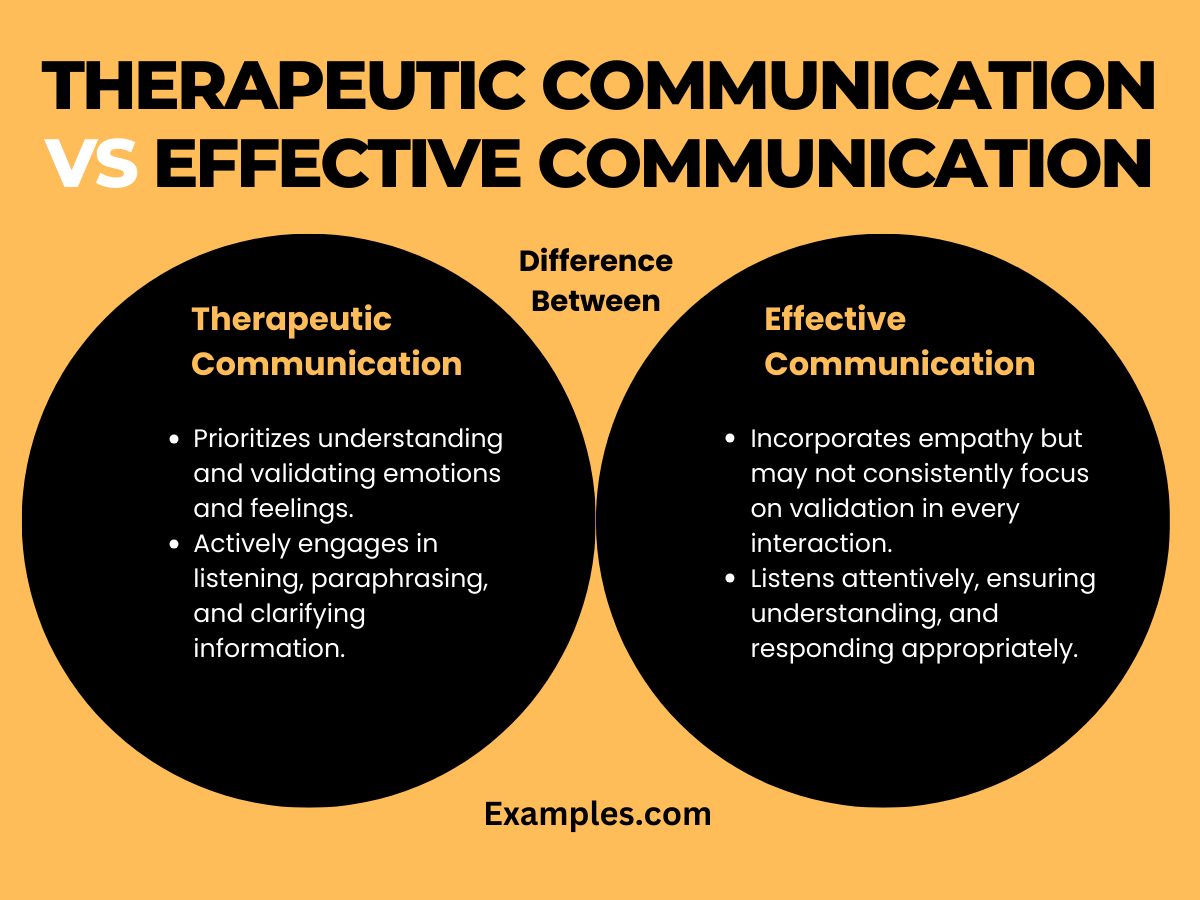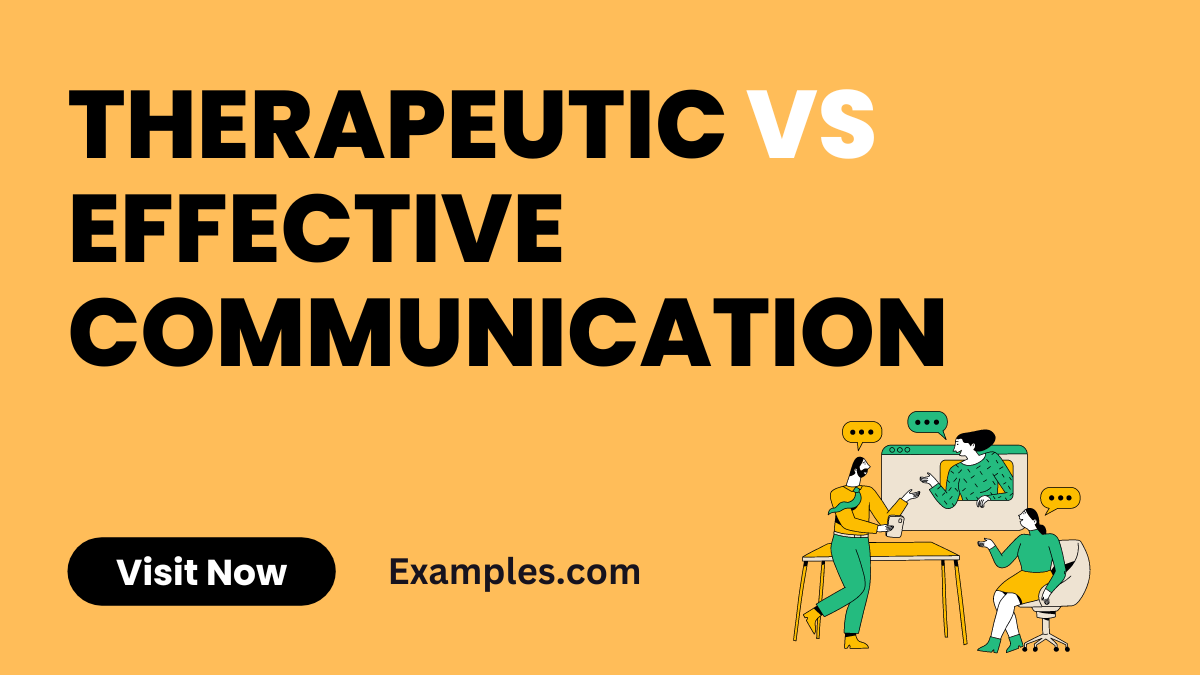Therapeutic Communication vs Effective Communication – 19+ Examples
Embark on a journey to master the subtleties of Therapeutic Communication vs Effective Communication. Uncover nuanced examples, usage tips, and expert strategies tailored to enhance your interpersonal skills. Whether navigating therapeutic settings or daily interactions, this guide delves into real-world communication examples, providing valuable insights and empowering you with effective strategies for diverse communication scenarios. Elevate your connections with this illuminating guide on Therapeutic and Effective Communication Examples.
What is the difference between Therapeutic Communication and Effective Communication?

Understanding the disparities between therapeutic and effective communication is crucial for navigating diverse interpersonal scenarios. This comprehensive guide provides an in-depth comparison between these two communication styles, presenting their unique characteristics and applications in a clear table format.
| Aspect | Therapeutic Communication | Effective Communication |
|---|---|---|
| Purpose | Focuses on healing, support, and understanding in professional settings. | Geared towards clear, impactful exchanges for successful outcomes. |
| Goal | Aims to promote trust, empathy, and positive mental health results. | Strives for clarity, understanding, and achieving specific objectives. |
| Setting | Primarily in healthcare, counseling, or supportive environments. | Applicable in diverse settings, from business meetings to personal interactions. |
| Verbal Expression | Emphasizes clarity, supportive language, and active listening skills. | Prioritizes precision, articulate expression, and conveying messages effectively. |
| Non-Verbal Cues | Open body language, focused eye contact, and empathetic gestures. | Utilizes diverse non-verbal cues to enhance understanding and convey confidence. |
| Empathy and Validation | Prioritizes understanding and validating emotions and feelings. | Incorporates empathy but may not consistently focus on validation in every interaction. |
| Active Listening | Actively engages in listening, paraphrasing, and clarifying information. | Listens attentively, ensuring understanding, and responding appropriately. |
| Patient Involvement | Encourages patient participation and shared decision-making. | Involves both parties contributing to the conversation, ensuring mutual engagement. |
| Relationship Building | Strengthens therapeutic alliances for positive outcomes. | Establishes connections for successful collaborations and positive interpersonal relationships. |
| Use of Silence | Utilizes purposeful silence for reflection or understanding. | Leverages silence contextually, considering its impact on the effectiveness of communication. |
| Feedback and Reflection | Provides constructive feedback, fostering personal growth. | Offers feedback tailored for improvement, ensuring continuous development. |
| Cultural Sensitivity | Demonstrates cultural competence and sensitivity in diverse contexts. | Adapts communication to align with cultural nuances and ensure inclusivity. |
By exploring these distinctions, individuals can adapt their communication style based on context, fostering effective interactions in both therapeutic and general communication scenarios.
10 Therapeutic Communication Examples
Explore therapeutic communication examples designed to foster understanding and connection. Each example is meticulously crafted to enhance your communication skills in diverse contexts, from healthcare to daily interactions. Elevate your ability to empathize, listen actively, and support others effectively.
- Active Listening:
Example: Boldly engage, “I hear your concerns; let’s discuss how we can address them.” - Empathetic Responses:
Example: Demonstrate understanding, “I can see this situation is challenging for you; I’m here to support.” - Open-Ended Questions:
Example: Encourage sharing, “Can you elaborate on how you’ve been feeling lately?” - Reflective Techniques:
Example: Use reflection, “It seems like you’re feeling overwhelmed; tell me more about it.” - Cultural Sensitivity:
Example: Acknowledge diversity, “I appreciate your perspective; let’s align our approach with your cultural preferences.” - Silence as Support:
Example: Provide reflection time, “Take your time; I’m here whenever you’re ready to talk.” - Validation of Feelings:
Example: Acknowledge emotions, “Your feelings are valid; let’s work through this together.” - Positive Reinforcement:
Example: Recognize efforts, “I noticed your dedication; it’s making a positive impact.” - Clarification:
Example: Ensure understanding, “Let me confirm I grasp what you’re saying…” - Problem-Solving Collaboration:
Example: Collaborate on solutions, “Let’s brainstorm together for a solution that suits both of us.”
These therapeutic communication examples empower you to establish connections, provide support, and contribute to positive outcomes in various interpersonal interactions.
10 Effective Communication Examples
Explore effective communication examples tailored to enhance your ability to convey thoughts and ideas with precision and impact. Each example is crafted to improve your skills in various settings, from professional environments to personal interactions. Elevate your communication prowess with strategies that emphasize clarity, active listening, and understanding.
- Clear and Concise Messaging:
Example: Boldly express, “Let’s streamline our approach to ensure everyone is on the same page.” - Active Listening in Meetings:
Example: Listen attentively, “I understand your concerns; let’s address them in the next agenda item.” - Empathetic Acknowledgment:
Example: Acknowledge feelings, “I can see this project is stressful for you; how can I assist?” - Constructive Feedback Delivery:
Example: Offer feedback, “Your input is valuable; consider incorporating it for an even stronger proposal.” - Email Clarity and Structure:
Example: Write clearly, “To ensure efficiency, let’s outline our action items in bullet points.” - Positive Reinforcement:
Example: Recognize achievements, “Your dedication to this project is driving exceptional results.” - Conflict Resolution Dialogue:
Example: Address conflicts, “Let’s discuss the issue openly and find a resolution that benefits all parties.” - Effective Presentation Techniques:
Example: Engage the audience, “Use visuals to complement key points and enhance audience understanding.” - Feedback Solicitation:
Example: Seek opinions, “What are your thoughts on this proposal? Your insights are invaluable.” - Adaptability in Communication Styles:
Example: Adjust to the audience, “Tailor your message to resonate with the preferences of your diverse team.”
These effective communication examples empower you to navigate diverse scenarios with precision, fostering clarity and understanding in your interactions.
What is the comparison between Therapeutic Communication and Effective Communication?
Navigating the nuances between therapeutic and effective communication is essential for success in diverse interpersonal interactions. This detailed guide presents a thorough comparison between these two communication styles, highlighting their unique characteristics, goals, and applications.
| Aspect | Therapeutic Communication | Effective Communication |
|---|---|---|
| Purpose | Focuses on healing, empathy, and support in professional settings. | Aims for clarity, understanding, and precision in various contexts. |
| Goal | Aims to establish trust, rapport, and positive outcomes in therapeutic contexts. | Seeks to convey information, ideas, or emotions with impact and clarity. |
| Setting | Predominantly in healthcare, counseling, or supportive environments. | Encompasses a broad range of settings, from professional to personal interactions. |
| Verbal Expression | Emphasizes supportive language, active listening, and empathy. | Prioritizes clarity, concise messaging, and effective expression of ideas. |
| Non-Verbal Cues | Open body language, empathetic gestures, and focused eye contact. | Diverse and context-dependent, may vary based on cultural and social factors. |
| Empathy and Validation | Focuses on understanding, validating emotions, and providing emotional support. | Balances empathy with a more objective approach, emphasizing understanding. |
| Active Listening | Actively engages in listening, paraphrasing, and clarifying information. | Prioritizes attentive listening, ensuring accurate comprehension and response. |
| Patient Involvement | Encourages patient participation and shared decision-making. | Involves both parties contributing to the conversation for effective outcomes. |
| Relationship Building | Strengthens therapeutic alliances to support positive outcomes. | Establishes connections based on mutual understanding and effective collaboration. |
| Use of Silence | Utilizes purposeful silence for reflection and understanding. | Silence is context-dependent, may occur naturally, and serves diverse purposes. |
| Feedback and Reflection | Provides constructive feedback to foster personal growth. | Feedback styles may vary, ranging from constructive criticism to positive reinforcement. |
| Cultural Sensitivity | Demonstrates cultural competence and sensitivity. | Adapts communication to diverse cultural backgrounds, showing respect and understanding. |
By exploring these distinctions, you gain a comprehensive understanding of how therapeutic and effective communication differ, enabling you to adapt your approach based on specific contexts and desired outcomes.
What is the relationship between Therapeutic Communication and Effective Communication?
Understanding the relationship between therapeutic and effective communication is crucial for fostering meaningful connections. This comprehensive guide outlines the distinctive qualities of each approach, emphasizing their shared goals and unique applications in diverse settings.
| Aspect | Therapeutic Communication | Effective Communication |
|---|---|---|
| Goal Alignment | Aims for healing, understanding, and emotional support in professional environments. | Strives for clear understanding, mutual agreement, and conveying messages for specific outcomes. |
| Focus | Centers on the patient’s needs, emotions, and fostering a therapeutic relationship. | Centers on the clarity of the message, engaging the audience, and achieving specific communication goals. |
| Setting | Predominantly in healthcare, counseling, or supportive environments. | Applicable in various settings, including professional, personal, and social interactions. |
| Verbal Expression | Emphasizes clear, supportive language, active listening, and therapeutic rapport. | Prioritizes clear and concise expression, tailored to the audience, and achieving intended outcomes. |
| Non-Verbal Cues | Utilizes open body language, eye contact, and empathetic gestures to convey understanding. | Adapts non-verbal cues based on the context, ensuring alignment with the message and audience. |
| Empathy and Validation | Focuses on understanding, validating feelings, and providing emotional support. | Integrates empathy while maintaining a focus on achieving understanding and agreement. |
| Active Listening | Actively engages in listening, paraphrasing, and clarifying information in therapeutic contexts. | Listens actively to comprehend, responds appropriately, and ensures understanding in various scenarios. |
| Patient Involvement | Encourages patient participation and shared decision-making in therapeutic settings. | Involves both parties contributing to the conversation, tailoring communication for mutual understanding. |
| Feedback and Reflection | Provides constructive feedback for personal growth in therapeutic relationships. | Offers feedback for improvement and refinement of communication strategies in diverse interactions. |
| Cultural Sensitivity | Demonstrates cultural competence and sensitivity in therapeutic contexts. | Adapts communication to diverse cultural backgrounds, ensuring inclusivity and understanding. |
Understanding the nuanced relationship between therapeutic and effective communication allows individuals to tailor their approach based on the context, creating more impactful interactions in various situations.
In conclusion, comprehending the distinctions between Therapeutic Communication and Effective Communication is paramount for effective interpersonal dynamics. This comprehensive guide illuminates their unique attributes with practical examples. Whether in healthcare or everyday interactions, mastering these communication styles fosters understanding, clarity, and positive outcomes. Empower yourself to navigate diverse scenarios, building connections and achieving communication success.



